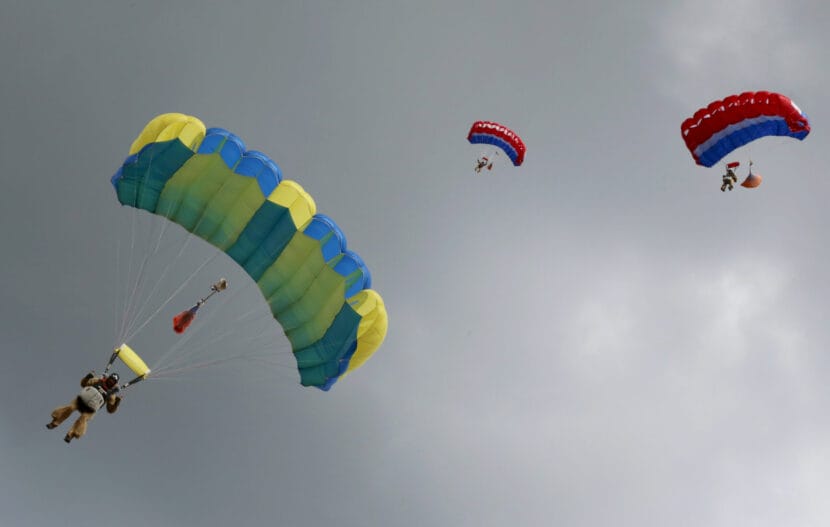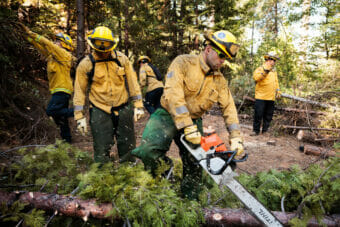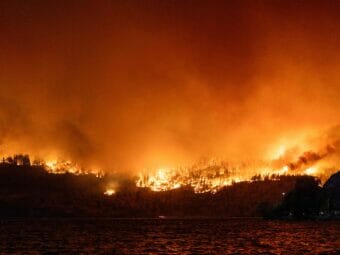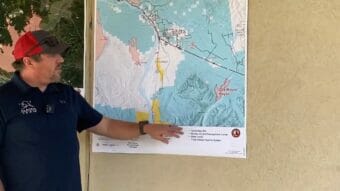
Alaska is heading into wildfire season, and firefighters are gearing up to be ready for it.
That includes smokejumpers, who parachute in to fight some of the most remote fires, often providing the first boots-on-the-ground attack as they try to keep the flames from spreading out of control.
One smokejumper based in Alaska is Dylan Brooks with the Bureau of Land Management‘s Alaska Smokejumpers. Brooks was in Anchorage recently talking to kids about his job as part of Campbell Creek Science Center’s Outdoor Week.
And as he explains, smokejumping is among the most elite — and exciting — firefighting there is.
Listen:
This interview has been lightly edited for length and clarity.
Dylan Brooks: Smokejumping is the one where you get to jump out of airplanes. And working at all with aircraft is fun. And it has the added layer of being, most people to get into it have a lot of fire experience. And then the physical standards are really high. So it has evolved into a fairly elite group within firefighting. And so all those combined for it to have a high draw in that regard.
Casey Grove: Can you describe for me what it’s like to go on a jump? I know there’s probably like a ton of preparation and just keeping yourself fit to be able to do this job. But when it’s actually time to go, what’s that like?
Dylan Brooks: In the morning, you’re just doing your normal day at work. We’re rigging parachutes that have been jumped before. We’re packing boxes of gear. We’re fixing things. We’re manufacturing our equipment. So you’re doing that throughout the day, all the while knowing in the back of your head that when that siren goes off, you have two minutes to drop whatever you’re doing, sprint to the rack where all your gear’s hanging, put it on and be walking out to the airplanes, that’s engines are already turning, and they’re getting ready to do the run up. You’re geared up in about 90 pounds of gear, and you gotta get on the plane.
Sometimes you’re flying five minutes, sometimes you’re flying two hours all the way across the state. You don’t know how long you’re going to be out there. So built into all that is the, you have a two-minute heads up that you’re leaving for two weeks kind of thing. You’re gonna do a buddy check with everybody on the plane. They’re gonna make sure all their gear is on right. Five minutes out, you’re gonna get another shorter version of the same check for all the critical elements. By that time, you’re starting to look for the fire. They’ve sent from dispatch all the information that you might want beforehand: how big, where it’s at, are there other people at the fire already? Are there aircraft on scene? That sort of thing. And then you’re getting close. And if you see it and all that, the door’s coming open on the airplane, people are talking, looking at the fire, speculating, just making a plan.
Casey Grove: So, I mean, we’re approaching the point where we’re actually gonna like jump out of the plane. But what goes through your mind and what’s happening in that?
Dylan Brooks: Yeah, there’s not a lot of things that I’ve done in my life that are more fun than that. It’s kind of surprising to a lot of people, we do seated exits. So we sit in the door of the plane, flying about 120 miles an hour, give or take, and you’re just looking at the world, 3,000 feet below you. And then you get a slap on the shoulder and push yourself off the side of the plane with your hands. And yeah, it’s pretty exciting. Parachute opens up, and then it’s just a really calming thing, because it’s so loud in the airplane. The whole flight’s loud. Sitting in the door’s loud. When you’re having the fall from the plane, under our small parachute, that’s loud. Then your main parachute opens up, and the world goes dead silent. That’s, yeah, that’s a pretty good feeling.
Casey Grove: That sounds kind of cool.
Part of why I wanted to talk to you about this is, you know, we’re heading into fire season, obviously. I guess you guys have been out already. But this feels like the time of year where people start to worry about people’s bad behavior with campfires or, you know, “are we gonna have a lot of lightning storms?” and that kind of thing. “Is everything drying out out there?” We hear a lot about climate change and how there’s more brush in different areas. And we’ve seen fires in places, big fires, in places that you wouldn’t have maybe expected it. Do you worry about that stuff? I mean, is it on your mind that like, “Oh, it’s gonna be a bad fire season?” Or what do you think about that?
Dylan Brooks: I would say for the most part, the larger context of things, climate, all those sort of urban interface-type stuff that doesn’t really play into the day-to-day feeling that you may have. But it’s the kind of thing you chit chat about at work and discuss sort of here and the ins and outs and that sort of thing. But then the weather, we’re watching the weather every morning. It’s the main topic of discussion. We all like to be out in the woods, and we like to jump fires, so we pay attention pretty closely to the weather and track all the storms and yeah.
Casey Grove: Why do we need smokejumpers? I mean, like why can’t you just have like a helitack crew or whoever, you know, to get there? What is the benefit, I guess, of having somebody parachute in?
Dylan Brooks: A lot of fires don’t have anywhere to land a helicopter nearby. Fixed wing aircraft are faster. They can fly for longer. And over the years, because smokejumping has attracted a certain type of individual, and also has sort of the rigorous standards to be in it, you may order them to a fire where you already have people on the ground, because you know you’re getting experienced hardworking people to come out of the plane. Especially in Alaska, smokejumping is a critical role. We don’t have a road system in very much of the state, and we’re able to do all sorts of missions anywhere in the state, pretty much within one fuel cycle.



